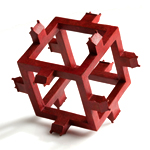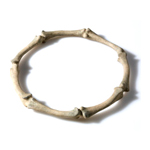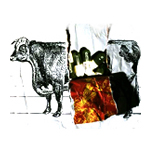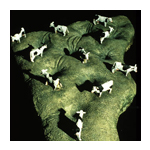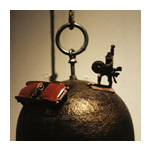|
|
Since the early 1990's I have been making sculpture that concerns itself with the landscape in the sense of the multiple, overlapping contexts for both individual human lives and collective human activity. The distinction between "landscape" and "me/us" has always seemed arbitrary and simplistic to me; a convenient myth that foregrounds the importance of the self-directed individual over the systems and context that define, delineate and determine each and every single one of us. One of the core problems of figurative sculpture is that the familiar and attractive form of the individual human figure will always tend to diminish the context, the wider panorama, which constantly reinforces the opposing idea of the centrality and primacy of the individual and their perspective. That perspective is a vital part of the human landscape we all live in and are shaped by, but it is not a full, or even a very useful description of the landscape of the human condition. In spite of Post-modernist claims to have killed the idea of an over-arching, objective truth, none of us seem capable of resisting the need to construct some form of external framework that supports our sense of self. I am interested in finding means to express and explore that contradictory partiality and some of the structural forces and strategies that surround, constrain and shape us. Recently I have been producing several parallel, open-ended suites of domestic-scale bronze editions that aim to explore some of these issues. An interest in the diagram, the model, the toy, the icon, the game and the map keep me intrigued by the possibilities of the smaller scale and constantly remind me that all conceptual and representational schema inevitably involve reduction, simplification and concision. What purpose would an inflated scale serve? I'm reminded of Borges' gloriously concise critique in his parable "Of Exactitude in Science" ( in "A Universal History of Infamy" ) where the hubris of a one to one scale map erodes its own functionality and eventually even the standing of its own form.... |
In 1991, during the first Gulf War, I made pieces that aimed to express the insecurity and powerlessness that I felt in a world that seemed fragile and under danger of collapse as a result of geo-political and economic strategy. Toys and game-play references seemed to me well suited to describing simultaneously the brinkmanship activities of world leaders and the feelings of alienation and powerlessness the global situation engendered. |
During a residency at a school in Epping, Essex in 1992 I would commute from inner London Whitechapel to the bucolic outer edge of the city on a tube train that passed from East End poverty and squalor through suburbia, past the edge of the last remnants of the great, ancient Epping Forrest and even through fields of cows before reaching the affluent area just beyond the outer boundary of London. I became interested in expressing aspects of the landscape as a physical manifestation of multiple processes, some natural (geological, biological), some human (historical, political, economic). |
Through the mid to late 90's, as the British BSE "Mad Cow"scandal unfolded, I extended my expropriation of the toy cow as a contradictory emblem of the collision between our romantic views of the benign, peaceful and above all "natural" landscape and the reality of the human needs-orientated economic construct of the English rural panorama into various media: digital prints, digitally-assisted 3D collages and metal sculptures. |
The "Colonies" look at ways of portraying the shaping of our world by the cumulative action of multitudes of apparently independently-operating individuals, each of us the hero of our own story whilst we construct, or manoeuvre through various prickly hierarchal and ideological structures, not necessarily aware of the wider consequences of our actions, or of our position as an inherently structural and contributing part of the whole schema. |
The "Corpus" are an attempt to give form to that sense of being part of dynamic, biologically-driven systems, whose structures exhibit simultaneously an apparent sublime sophistication and divine order and pragmatic, organic, messy compromise. |
The "Im/Perfected Objects" were part of a search for a succinct means of expressing the contrast between our apparent need for ideals of perfection in our intellectual and spiritual constructions and the practical reality of the messy, complex, physical, material world that produces them. |
The "To Have and to Hold"s treat collective and individual identity, activity and ideology as part of larger strategic game processes. |
Copyright © 2010 Ludovik Boden, all rights reserved |
